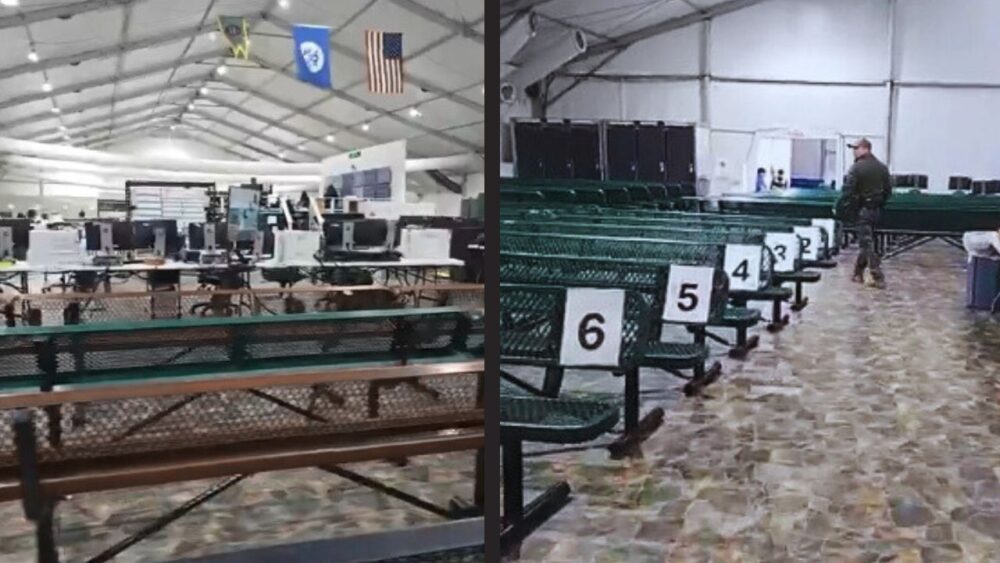The Chief of the U.S. Border Patrol’s Del Rio Sector posted a striking video to social media on Tuesday showing a once-overwhelmed migrant facility now reduced to a barren field, crediting the dramatic change to enhanced border security under the Trump administration.
“A lot has changed in the past few months!” the post on X from the U.S. Border Patrol Del Rio Sector read. “At its peak, this facility required about 750 employees to process thousands of illegal aliens every week, totaling about 700,000 over three years. Now, this empty lot serves as a reminder that the border is more secure than ever.”
A lot has changed in the past few months! At its peak, this facility required about 750 employees to process thousands of illegal aliens every week, totaling about 700,000 over three years. Now, this empty lot serves as a reminder that the border is more secure than ever. pic.twitter.com/INII8AptMM
— U.S. Border Patrol Del Rio Sector (@USBPChiefDRT) May 7, 2025
The post included a video scored to Journey’s Don’t Stop Believin’, juxtaposing footage of the facility in 2023 under the Biden administration with scenes from the same location in spring 2025 under President Donald Trump.
In the 2023 visuals, long lines of migrants—presumably illegal aliens—stream through makeshift facilities staffed by hundreds of federal workers. Many carry items distributed by authorities or are wrapped in foil-like space blankets. Temporary structures stretch across the border landscape: rows of tents, trailers, and a fleet of federal vehicles.
By contrast, the 2025 footage under Trump shows a starkly diminished footprint—just a few officials visible and the facility nearly empty. The footage ends with a drone shot revealing a cleared field where the hub once stood.
The change comes amid a flurry of executive actions by the Trump administration aimed at securing the southern border, reinforcing immigration enforcement, and deterring illegal entry.
According to an April 28, 2025, White House fact sheet, “Illegal border encounters are down by 95%,” while “Illegal immigrant ‘gotaways’ — the top threat to public safety — are down by 99%.”
America’s military organizations have come to aid border security efforts. In March, the U.S. Coast Guard announced it had increased its presence along the southwest border “to enhance border security, immigration enforcement and to protect the territorial integrity of the United States.”
Meanwhile, the Department of Defense recently announced the creation of a second military zone that extends into Texas. The new area, encompassing Fort Bliss Army base in El Paso, mirrors a similar zone established along the New Mexico border. Defense Secretary Pete Hegseth said at the time, “Any illegal attempting to enter that zone is entering a military base, a federally protected area. You will be interdicted by U.S. troops and Border Patrol,” per AP.
The Dallas Express previously reported that the administration boasted about 150,000 deportations in just 100 days. Assuming the pace holds, Trump could oversee approximately two million deportations by the end of his second term, an extraordinarily high figure but one that would be relatively small compared to the present illegal alien population.
It is difficult to imagine that these figures could be substantially increased without more support from Congress. Trump signed the Laken Riley Act into law in March, a bipartisan bill that mandates the federal detention of illegal aliens charged with serious crimes such as assault, burglary, and offenses resulting in serious injury or death.
However, there has not been major legislative action on immigration since the Laken Riley Act. There is limited media chatter about a reconciliation bill from the House of Representatives that reportedly includes nearly $80 billion for internal immigration enforcement. Still, it is unclear if the bill, in its current state, can succeed on the razor-thin Republican majority in the lower chamber.


